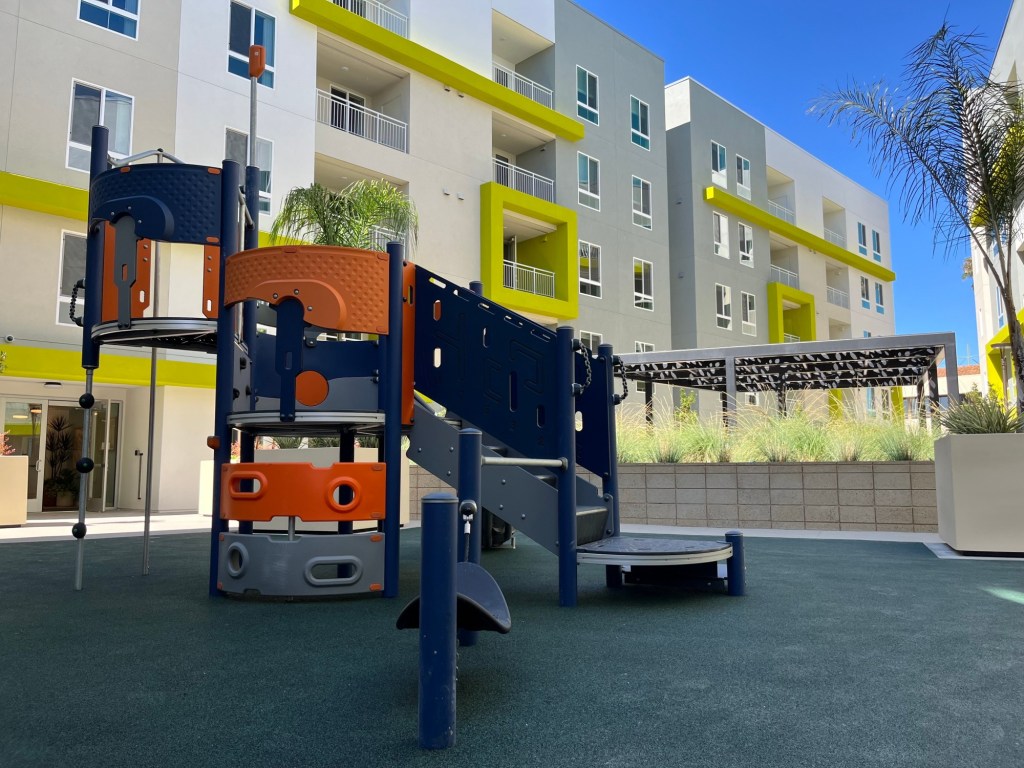Hundreds of affordable housing units opened this month throughout the city of San Diego, a crucial addition in a region where the number of people losing a place to stay continues to outpace how many homeless residents are able to leave the streets.
The 560 apartments are spread across multiple buildings in downtown San Diego, the Clairemont Mesa neighborhood and the Midway District. Some are set aside for homeless people, veterans or young adults.
“When we support affordable housing in our communities, we are creating a safe and stable living environment for all residents,” Kimberly Giardina, a leader at the county’s Health and Human Services Agency, said in a statement.
Downtown San Diego
Harrington Heights in downtown San Diego has 270 apartments.
The 15-story East Village building is for those with “extremely low income,” including formerly homeless individuals, leaders said in a press release. “Today, as we welcome the future residents of Harrington Heights, let us remember what this project represents — that this is a city that refuses to give up on its people,” Mayor Todd Gloria said in a statement.
Families can earn only 25% to 50% of San Diego’s Area Median Income to be eligible. That shakes out to an annual income of about $37,200 to $74,450 for a three-person household. The units must remain affordable for at least 55 years.
Forty apartment are reserved for residents with developmental disabilities. On-site supportive services, including free haircuts and a veterinarian who can work with emotional support animals, will be overseen by the nonprofit Alpha Project.
The building was developed by the Chelsea Investment Corporation and relied on a combination of local, state and federal funding.
The project’s overall affordability is partially dependent on vouchers that help residents pay rent, including those issued through the housing commission and the Veterans Affairs Supportive Housing program, or VASH.
That type of aid, however, may not be available indefinitely. Local officials previously said federal funding cuts could endanger some voucher programs in the coming years.
Clairemont Mesa neighborhood
The Mt. Edna Campus in the Clairemont Mesa neighborhood, near the intersection of Genesee and Balboa avenues, already opened one building earlier this year for low-income seniors.
The complex has now added two towers that collectively hold 228 apartments, officials announced. More than 70 of those are classified as permanent supportive housing, which is for residents needing ongoing supportive services.
The buildings are on county land that used to host a sheriff’s crime lab. The nonprofit Serving Seniors will provide supportive services.
Like Harrington Heights downtown, Mt. Edna was developed by the Chelsea Investment Corporation and relied on funding from the city, county, state and federal government. The complex is to remain affordable for at least 55 years.
A fourth building for low-income families is set to open early next year.
Midway District
Pacific Village in the Midway District is for veterans, young adults and those who’ve experienced homelessness.
The building is a converted hotel and holds 62 studio apartments. Fifteen are for homeless veterans.
Multiple levels of government similarly chipped in to support the renovations, and millions of dollars from the county will cover behavioral health services, which can treat both mental illnesses and substance use disorders.
Other efforts around the region aim to further boost the supply of affordable units.
For example, the county’s Department of Planning and Development Services recently decided that tiny homes on wheels can count as standalone houses or Accessory Dwelling Units in unincorporated communities. Those homes cannot be larger than 430 square feet and must be used as residences, not short-term rentals.
In September, more than 1,100 people countywide became homeless for the first time, according to the Regional Task Force on Homelessness. Only 1,032 homeless people got housing during the same period.
By that measure, the crisis has grown during eight of the last nine months.

